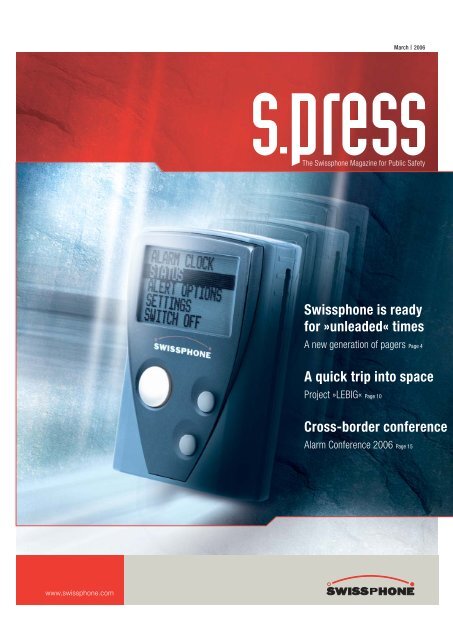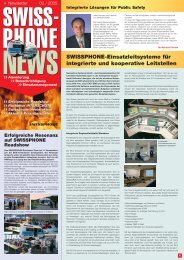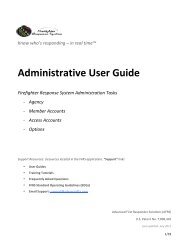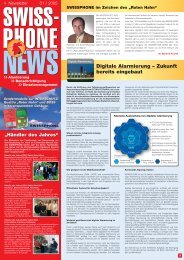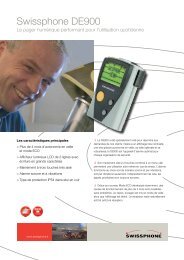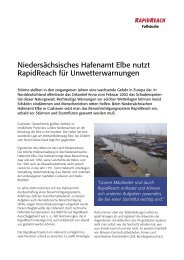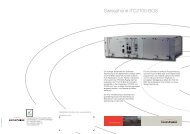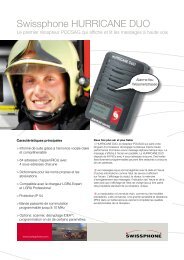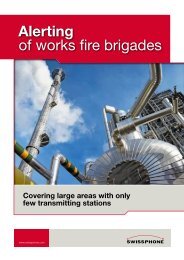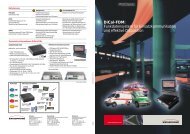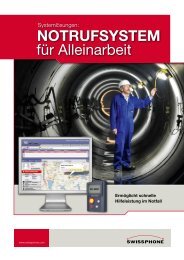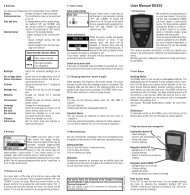Swissphone is ready for »unleaded« times A quick trip into space ...
Swissphone is ready for »unleaded« times A quick trip into space ...
Swissphone is ready for »unleaded« times A quick trip into space ...
Create successful ePaper yourself
Turn your PDF publications into a flip-book with our unique Google optimized e-Paper software.
www.sw<strong>is</strong>sphone.com<br />
March | 2006<br />
The <strong>Sw<strong>is</strong>sphone</strong> Magazine <strong>for</strong> Public Safety<br />
<strong>Sw<strong>is</strong>sphone</strong> <strong>is</strong> <strong>ready</strong><br />
<strong>for</strong> <strong>»unleaded«</strong> <strong>times</strong><br />
A new generation of pagers Page 4<br />
A <strong>quick</strong> <strong>trip</strong> <strong>into</strong> <strong>space</strong><br />
Project »LEBIG« Page 10<br />
Cross-border conference<br />
Alarm Conference 2006 Page 15
INSIDE<br />
CONTENTS INSIDE<br />
Editorial 03<br />
SOLUTIONS<br />
<strong>Sw<strong>is</strong>sphone</strong> <strong>is</strong> <strong>ready</strong> <strong>for</strong> <strong>»unleaded«</strong> <strong>times</strong> 04<br />
The latest command centre technology <strong>for</strong> the<br />
professional fire fighters of Linz 06<br />
Mobile command unit and redundant<br />
command & control centre 08<br />
A <strong>quick</strong> <strong>trip</strong> <strong>into</strong> <strong>space</strong> 10<br />
GLOBAL<br />
Locating mobile calls – towards a definite position 12<br />
EVENTS<br />
Cross-border conference 15<br />
<strong>Sw<strong>is</strong>sphone</strong> on location 16<br />
CeBIT, Hanover<br />
GPEC, Leipzig<br />
<strong>Sw<strong>is</strong>sphone</strong> Wireless Symposium/Berne
Helmut Köchler,<br />
President of the Board<br />
EDITORIAL<br />
Ladies and gentlemen, esteemed business<br />
partners,<br />
As al<strong>ready</strong> mentioned in the first <strong>is</strong>sue, we want to<br />
use th<strong>is</strong> magazine not only to announce product<br />
news and updates, but also to in<strong>for</strong>m you about<br />
current trends, developments and technologies<br />
in the Public Safety industry. Our second <strong>is</strong>sue of<br />
s.press, there<strong>for</strong>e, contains implementation and<br />
usage reports <strong>for</strong> the latest solutions in alarm systems,<br />
operations controlling and communications;<br />
an update on the local<strong>is</strong>ation of emergency calls<br />
made from GSM phones; and an introduction to<br />
our new generation of pagers.<br />
You may not yet be aware of the significance of the<br />
WEEE and RoHS regulations <strong>for</strong> electrical and<br />
electronic devices, enacted by the European<br />
Parliament in 2003 <strong>for</strong> the better protection of<br />
02 | 03<br />
humans and the environment. Effective 1 July 2006,<br />
new electrical and electronic devices may (amongst<br />
others) not contain any lead, mercury, cadmium or<br />
other harmful substances. Being the market leader<br />
in the alarm systems sector, <strong>Sw<strong>is</strong>sphone</strong> <strong>quick</strong>ly responded<br />
with the necessary measures, meeting<br />
the new regulations ahead of time to ensure a fully<br />
compliant product range free of lead and other<br />
harmful substances. Here at <strong>Sw<strong>is</strong>sphone</strong>, we want<br />
you to know you can depend on us.<br />
We hope you will find th<strong>is</strong> publication a stimulating<br />
and in<strong>for</strong>mative read.<br />
Helmut Köchler<br />
The <strong>Sw<strong>is</strong>sphone</strong> Magazine <strong>for</strong> Public Safety
SOLUTIONS<br />
<strong>Sw<strong>is</strong>sphone</strong> <strong>is</strong> <strong>ready</strong><br />
<strong>for</strong> <strong>»unleaded«</strong> <strong>times</strong><br />
In early 2003, the European Parliament enacted its new WEEE and RoHS directives <strong>for</strong> electrical and<br />
electronic devices in an ef<strong>for</strong>t to better protect humans and the environment. As the number of<br />
offending devices <strong>is</strong> r<strong>is</strong>ing drastically in today’s technology-driven society, the objective of these<br />
regulations <strong>is</strong> to instate legally en<strong>for</strong>ceable preventative measures. Th<strong>is</strong> <strong>is</strong> of particular importance<br />
to waste management, i.e., when the devices reach the end of their lifecycle. Al<strong>ready</strong> today, market<br />
leader <strong>Sw<strong>is</strong>sphone</strong> <strong>is</strong> exemplary in anticipating the lead-free future of electronics production –<br />
as <strong>is</strong> evidenced by the company’s three new BOS-certified pagers.<br />
New standards in safety: As of 1 July 2006, the<br />
EU’s RoHS (Restriction of certain Hazardous<br />
Substances) directive will prohibit dangerous<br />
substances such as lead, mercury and cadmium<br />
from being used in the production of new<br />
electrical and electronic devices. Working in<br />
parallel to RoHS <strong>is</strong> the WEEE (Waste of Electrical<br />
and Electronic Equipment) regulation towards<br />
reducing stress on the environment both during and<br />
after the device lifespan. WEEE further encourages<br />
recycling and re-use as feasible waste management<br />
options.<br />
<strong>Sw<strong>is</strong>sphone</strong> responded to these new prem<strong>is</strong>es<br />
immediately. After the enactment of the regulations<br />
in 2003, the company extensively researched all<br />
associated <strong>is</strong>sues and defined a set of new production<br />
solutions. In July 2005, following exhaustive<br />
material and process testing, <strong>Sw<strong>is</strong>sphone</strong> switched<br />
to RoHS-compliant machine soldering <strong>for</strong> the<br />
assembly of end devices as well as RoHS-compliant<br />
manual soldering. Six months later, all of the<br />
company’s production processes were redesigned<br />
to be completely lead-free. <strong>Sw<strong>is</strong>sphone</strong>’s products<br />
and components are labelled accordingly.<br />
Similarly, all receivers and chargers manufactured<br />
since August 2005 comply with the new<br />
WEEE regulations, as <strong>is</strong> shown by the<br />
official WEEE logo printed on every device.<br />
Ongoing development as a permanent challenge<br />
The necessary production changes were substantial<br />
and costly, which <strong>is</strong> why <strong>Sw<strong>is</strong>sphone</strong> made sure<br />
from the outset to comply with the underlying criteria<br />
of the new EU regulations. The company has<br />
always aimed <strong>for</strong> environmentally friendly product<br />
Author: Deborah Bucher · Corporate Communications<br />
development that <strong>is</strong> in keeping with international<br />
standards – in fact, <strong>Sw<strong>is</strong>sphone</strong> has never ceased<br />
to invest in <strong>for</strong>ward-looking technologies and<br />
development. At the same time, however, the changeover<br />
from lead-based production to lead-free<br />
RoHS-compliant production had to be well-planned<br />
and seamless. Product quality was not to be<br />
comprom<strong>is</strong>ed at any point, and extensive testing<br />
had to be conducted throughout the transition<br />
process.<br />
As a result, <strong>Sw<strong>is</strong>sphone</strong>’s new generation of<br />
pagers <strong>is</strong> character<strong>is</strong>ed by excellent quality,<br />
up-to-date design and intuitive operation – while<br />
still providing a maximum of reliability and<br />
ruggedness. The three latest units, all of them<br />
RoHS-compliant, are exemplary in meeting<br />
the new requirements.<br />
A new generation of pagers – with added flexibility and<br />
user-friendliness<br />
The outstanding feature of the DE925 <strong>is</strong> its illuminated<br />
graphical d<strong>is</strong>play. With four or five lines, each<br />
optionally containing 16, 20 or 21 characters, the<br />
d<strong>is</strong>play v<strong>is</strong>ually enhances the updated menu layout.<br />
Combined with simple three-button operation, th<strong>is</strong><br />
guarantees reliable interaction even in emergency<br />
scenarios. Further advantages of the DE925 include<br />
a variable reception frequency – adjustable by +/-<br />
500 kHz thanks to PLL (Phase Locked Loop)<br />
technology – and the option of controlling the pager<br />
remotely using OAP (On-Air Programming) messages.<br />
The DE920 Ex <strong>is</strong> the sleeker, lighter and face-lifted<br />
successor of the DE516C Ex. Essentially featuring<br />
the same advantages as the 920 units, th<strong>is</strong> rugged
yet easy-to-use pager <strong>is</strong> the most suitable receiver<br />
to use in explosion-r<strong>is</strong>k environments. It has<br />
been designed specifically <strong>for</strong> the chemical, gas<br />
and petrol industries.<br />
<strong>Sw<strong>is</strong>sphone</strong> <strong>is</strong> also releasing a new analogue unit:<br />
The RE629 receiver has been designed <strong>for</strong><br />
use in challenging meteorological conditions and <strong>is</strong><br />
compliant with IP54 specifications (complete<br />
dust and splash water resilience). Ongoing product<br />
development of the ex<strong>is</strong>ting pager models has<br />
resulted in even greater user-friendliness thanks to<br />
a brighter d<strong>is</strong>play and larger characters. Battery<br />
usage remains cons<strong>is</strong>tently low despite the added<br />
user com<strong>for</strong>t.<br />
04 | 05<br />
The simple-to-use model <strong>for</strong> deployment and<br />
management personnel can easily be integrated<br />
<strong>into</strong> alarm and d<strong>is</strong>patch system of any dimension,<br />
whereas the top-of-the-line model <strong>is</strong> designed <strong>for</strong><br />
top-level personnel with extended areas of<br />
responsibility, as well as <strong>for</strong> general users requiring<br />
soph<strong>is</strong>ticated features. Thanks to a broad spectrum<br />
of easy-to-program options (PLL technology),<br />
the devices can be integrated <strong>into</strong> ex<strong>is</strong>ting<br />
analogue networks of any kind. Next to the new<br />
pagers’ ecological soundness, th<strong>is</strong> makes them<br />
a reliable investment <strong>into</strong> the future.<br />
The <strong>Sw<strong>is</strong>sphone</strong> Magazine <strong>for</strong> Public Safety
SOLUTIONS<br />
The latest command centre technology <strong>for</strong><br />
the professional fire fighters of Linz<br />
The professional fire service of Linz has been using the latest command centre software from<br />
<strong>Sw<strong>is</strong>sphone</strong> <strong>for</strong> their deployment coordination since September 2005. The software <strong>is</strong> tailored to the<br />
wide range of tasks <strong>for</strong> which th<strong>is</strong> command & control centre <strong>is</strong> responsible. Custom<strong>is</strong>ed solutions<br />
allow numerous subsystems to be integrated in order to ensure that the approximately 4,500 annual<br />
deployments run smoothly.<br />
Eurobird<br />
The city of Linz, which has around 200,000 inhabitants<br />
and covers an area of 94km 2 , <strong>is</strong> protected<br />
by the Operations Command and Control System<br />
of the Linz D<strong>is</strong>trict Warning Centre/The In<strong>for</strong>mation<br />
Centre of the Linz Professional Fire Service. Th<strong>is</strong><br />
body coordinates and controls the deployment<br />
of the professional fire service in Linz, as well as the<br />
city‘s four volunteer fire services. It also coordinates<br />
the regional fire service control centre of Upper<br />
Austria and supports other emergency services<br />
organ<strong>is</strong>ations, such as police and rescue services,<br />
in many of their m<strong>is</strong>sions.<br />
In addition to fighting fires and providing technical<br />
ass<strong>is</strong>tance, the D<strong>is</strong>trict Warning Centre <strong>is</strong> responsible<br />
<strong>for</strong> the operational command of d<strong>is</strong>aster<br />
response. To th<strong>is</strong> end, a standalone workstation<br />
has been installed in the central fire station’s<br />
command office. Th<strong>is</strong> workstation <strong>is</strong> used as the<br />
communication and in<strong>for</strong>mation hub in the case<br />
of a d<strong>is</strong>aster.<br />
The volunteer fire services on the outskirts of the city<br />
and the fire services provided by industry in the<br />
industrial zones are then mobil<strong>is</strong>ed in addition to the<br />
resources of the professional fire service.<br />
Author: Tanja Oudot · Customer Service & Training<br />
The computer-aided d<strong>is</strong>patch system: capable and flexible<br />
The secur.CAD/fire d<strong>is</strong>patch system from <strong>Sw<strong>is</strong>sphone</strong><br />
provides the Linz professional fire service with<br />
a modern, high availability system tailored to the<br />
specific needs of the fire service control centre.<br />
The system enables a rapid and secure response<br />
to every emergency call. The relevant in<strong>for</strong>mation<br />
on all operation locations <strong>is</strong> prepared and<br />
d<strong>is</strong>played as befits the situation. D<strong>is</strong>patchers<br />
using th<strong>is</strong> command centre software have a clear<br />
and up-to-the-minute overview of the status<br />
of resources thanks to the vehicle status d<strong>is</strong>play<br />
and the Geographical In<strong>for</strong>mation System (GIS).<br />
They can view the status of all 66 professional<br />
fire service vehicles and the 15 volunteer fire<br />
service vehicles.<br />
Swap body vehicles and containers can be matched<br />
using a simple drag and drop procedure. The<br />
system automatically suggests the appropriate swap<br />
body <strong>for</strong> a container.<br />
The database contains around 2,000 streets and<br />
squares, 200 high-r<strong>is</strong>e buildings and 20,000 other
uildings. Furthermore, the data of large-scale<br />
industry, e.g. VÖEST AG and the Linzer Chemical<br />
Park, are included in the d<strong>is</strong>patch system. Around<br />
350 automatic fire alarms are currently linked to the<br />
Linz professional fire service; notifications from<br />
a further 50 non-automatic fire alarms arrive via the<br />
in<strong>for</strong>mation centre.<br />
All strategically relevant data, from the acceptance<br />
through to the end of a m<strong>is</strong>sion, and all<br />
vehicles deployed in the operation, are recorded<br />
by the d<strong>is</strong>patch system and stored in a database.<br />
Th<strong>is</strong> data <strong>is</strong> accessed by the fire in<strong>for</strong>mation<br />
system FIS. Th<strong>is</strong> programme manages the<br />
d<strong>is</strong>patch of personnel, equipment and machinery<br />
as well as generating a report and a stat<strong>is</strong>tical<br />
analys<strong>is</strong>.<br />
Synthetic voice alarms<br />
When an emergency call <strong>is</strong> received, the operations<br />
control computer supports the d<strong>is</strong>patcher, in the<br />
selection of the nearest suitable vehicles and generates<br />
an automatic alarm. A special feature installed<br />
<strong>for</strong> the Linz professional fire service <strong>is</strong> the synthes<strong>is</strong>ed<br />
voice which announces the alarm. The advantage<br />
of th<strong>is</strong> system <strong>is</strong> that the announcement <strong>is</strong> always<br />
made in the same emotionless tone, regardless<br />
of the type of alarm or the stress-level of the<br />
d<strong>is</strong>patcher.<br />
The notification of the emergency personnel <strong>is</strong><br />
supported by a PLC (Programmable Logic<br />
Controller). Th<strong>is</strong> controller triggers the alarm signal<br />
and switches the corresponding lighting and<br />
speaker systems on. The announcement of the<br />
d<strong>is</strong>patch and of the resources to be deployed<br />
<strong>is</strong> repeated automatically. Gates, barriers and traffic<br />
lights are also automatically controlled.<br />
The d<strong>is</strong>patch software also supports an automatic<br />
telephone alert system to notify authorities using an<br />
interface software, which speaks the incident text.<br />
Th<strong>is</strong> function can also be used <strong>for</strong> major incidents<br />
where a large-scale alert <strong>is</strong> called <strong>for</strong>.<br />
The professional fire service uses the special box<br />
alarm function <strong>for</strong> all resources. All vehicles are<br />
assigned to an appropriate box <strong>for</strong> th<strong>is</strong> purpose.<br />
Thus the in<strong>for</strong>mation on where the alert must<br />
take triggered <strong>is</strong> available throughout the system.<br />
If a vehicle <strong>is</strong> transferred to another station, giving<br />
it a dual function (<strong>for</strong> example, <strong>for</strong> the main station<br />
and the Northern station), the system automatically<br />
notifies the correct box and triggers the corresponding<br />
PLC actions, e.g. alarm signals or traffic lights,<br />
at that station.<br />
GIS maps in operation d<strong>is</strong>patch<br />
06 | 07<br />
D<strong>is</strong>patchers cannot be expected to know all of the<br />
detailed tactical in<strong>for</strong>mation relevant to operations in<br />
the greater Linz area. Th<strong>is</strong> makes a modern Geographical<br />
In<strong>for</strong>mation System with its soph<strong>is</strong>ticated<br />
functions and prec<strong>is</strong>e data and maps all the more<br />
important.<br />
In addition to the route, all important in<strong>for</strong>mation on<br />
the operation site and a map of the location are<br />
printed at operation d<strong>is</strong>patch control. The map gives<br />
the emergency response staff a rapid overview of<br />
the operation site and the surrounding area. Where<br />
buildings are endangered or at high r<strong>is</strong>k, the following<br />
in<strong>for</strong>mation can be imparted with the d<strong>is</strong>patch:<br />
data on the main building and surrounding<br />
buildings<br />
d<strong>is</strong>patch plans<br />
in<strong>for</strong>mation on operations in the vicinity<br />
alarm plans <strong>for</strong> particular operation types as well<br />
as in<strong>for</strong>mation on hazardous materials<br />
Two additional remote emergency call acceptance<br />
stations are occupied in the case of a major<br />
incident. The staff at these stations has access to<br />
maps and all in<strong>for</strong>mation relevant to the incident.<br />
The team thus has an overview of the current situation<br />
and can initiate the appropriate response<br />
activities.<br />
Fail safe<br />
A d<strong>is</strong>trict warning centre that <strong>is</strong> responsible <strong>for</strong> the<br />
safety of 200,000 inhabitants and 80,000 commuters<br />
over an area of 94km2 cannot r<strong>is</strong>k a failure of the<br />
command centre technology. For th<strong>is</strong> reason, the<br />
highest level of security in the <strong>for</strong>m of a mirrored<br />
system, an uninterruptible power supply and an emergency<br />
power supply are installed to provide back up<br />
<strong>for</strong> the operation and command & control centre.<br />
The <strong>Sw<strong>is</strong>sphone</strong> Magazine <strong>for</strong> Public Safety
SOLUTIONS<br />
Mobile command unit and<br />
redundant command & control centre<br />
Picture: Stephan Kuhn<br />
Major incidents, natural d<strong>is</strong>asters, simple day-to-day operations: No matter what the situation, the<br />
overall success of a d<strong>is</strong>patch will always depend on the communications system used. Today’s<br />
mobile command units are expected to provide instant mobile access to central<strong>is</strong>ed databases, the<br />
Internet and telephone systems.<br />
When the municipal fire brigade of Herne (Germany)<br />
invested in a new communications system, the<br />
technology it chose had to be up-to-date, fast and<br />
– most importantly – failsafe. Th<strong>is</strong> particularly<br />
applied to communications between the stationary<br />
command & control centre (C&CC) and the deployed<br />
command vehicle. The “ELW2” command<br />
vehicle used in Herne doubles as a fully redundant<br />
C&CC and functions as a mobile operations centre<br />
in the coordination of major incidents. Th<strong>is</strong> <strong>is</strong> of<br />
Author: Angelika Maier · Marketing<br />
vital importance when hardware or software failures<br />
occur at the stationary C&CC. Using a vehicle<br />
resource as a self-sufficient and fully redundant<br />
C&CC <strong>is</strong> still a very new concept; throughout<br />
Germany, there are only two vehicle types that<br />
provide th<strong>is</strong> level of functionality. Both have<br />
been equipped by <strong>Sw<strong>is</strong>sphone</strong>.<br />
The command vehicle type used in Herne contains<br />
three control workstations and a server. The
computer-aided d<strong>is</strong>patch system “secur.CAD” <strong>is</strong><br />
paired with powerful terminal server software to<br />
grant fast communications. Th<strong>is</strong> versatile system<br />
can be prec<strong>is</strong>ely adapted to individual incident<br />
locations, supporting the d<strong>is</strong>patchers in their operational<br />
and admin<strong>is</strong>trative tasks as efficiently as<br />
possible. The workstations are additionally equipped<br />
with the FIRECOM communications management<br />
system.<br />
router control centre network<br />
to Herne city network<br />
C&CC<br />
router city network<br />
C1 COM-server<br />
pcs00104<br />
COM-server<br />
PC <strong>for</strong> data exchange<br />
(Redolog files)<br />
main database<br />
Oracle 10g<br />
client 1<br />
client n<br />
“fl orian”-server<br />
Dynamic switching between communication networks<br />
When the command vehicle <strong>is</strong> located at the station,<br />
the mobile and stationary C&CC communicate via<br />
a WLAN connection at a speed of up to 108 Mbps.<br />
Once the vehicle <strong>is</strong> on the road and out of WLAN<br />
range, a satellite connection <strong>is</strong> establ<strong>is</strong>hed at the<br />
incident location. Thanks to its fast access design<br />
and straight<strong>for</strong>ward handling, the SatLink-BOS<br />
satellite system does not require special training to<br />
set up – it <strong>is</strong> up and running within minutes.<br />
When the satellite link <strong>is</strong> used <strong>for</strong> communications,<br />
data can be routed along four different networks:<br />
Vehicle network<br />
Control centre network<br />
EDP network of the Herne city council<br />
Virtual network<br />
Within th<strong>is</strong> framework, a broad range of communications<br />
can be facilitated. For example, data and<br />
d<strong>is</strong>patch plans at the C&CC can be accessed<br />
directly from the incident location. As the vehicle’s<br />
database replicates the data of the stationary C&CC<br />
(using an Oracle database server), the master data<br />
WLAN AP C&CC<br />
network<br />
WLAN AP repeater WLAN AP “ELW2”<br />
S S<br />
switch<br />
gateway <strong>for</strong> C&CC network<br />
router C&CC network<br />
router<br />
SATLink/VSAT S<br />
terminal server software<br />
secur.CAD<br />
terminal server<br />
SAT<br />
08 | 09<br />
of the two <strong>is</strong> identical. The same connection <strong>is</strong> used<br />
<strong>for</strong> telephone communications.<br />
When out of WLAN range, dynamic incident data<br />
(i.e., active operations) are updated 30 to no<br />
more than 60 minutes be<strong>for</strong>e switching. Th<strong>is</strong> means<br />
incident entry <strong>is</strong> possible directly in the vehicle.<br />
If the status messages <strong>is</strong>sued via the radio system<br />
are traced and updated manually, the d<strong>is</strong>patch<br />
can be monitored directly from the mobile control<br />
workstation.<br />
router<br />
router<br />
SATLink/VSAT M<br />
Router of C&CC network sends IP packages<br />
<strong>for</strong> city network to router of city network<br />
switch<br />
FC=FIRECOM<br />
Thanks to its soph<strong>is</strong>ticated technological infrastruccrange<br />
of functions. The following control situations<br />
can be facilitated:<br />
Mobile C&CC via SatLink<br />
“ELW2”<br />
gateway <strong>for</strong> “ELW2”<br />
hot standby database<br />
Oracle 10g<br />
FC-server<br />
terminal server client<br />
secur.CAD<br />
FC workstation 3<br />
terminal server client<br />
secur.CAD<br />
terminal server client<br />
secur.CAD<br />
FC workstation 2<br />
FC workstation 1<br />
Major incidents require a fully functional on-location<br />
C&CC to coordinate deployment measures. When<br />
the tactical functions are coordinated on location, the<br />
stationary C&CC only needs to provide support<br />
measures.<br />
Work<strong>space</strong> extension of the C&CC via WLAN<br />
When additional d<strong>is</strong>patchers are needed at the<br />
stationary operations control centre, the workstations<br />
contained in the ELW2 can double as additional<br />
work<strong>space</strong>s. In th<strong>is</strong> usage scenario, the command<br />
vehicle <strong>is</strong> located at the station and communicates<br />
via the WLAN.<br />
Mobile command unit with self-contained database<br />
Should SatLink be temporarily or permanently<br />
unavailable, operations can be controlled directly<br />
from the command vehicle. The same applies<br />
in case the stationary C&CC fails.<br />
The <strong>Sw<strong>is</strong>sphone</strong> Magazine <strong>for</strong> Public Safety
A <strong>quick</strong> <strong>trip</strong> <strong>into</strong> <strong>space</strong><br />
Command &<br />
Control Centre<br />
PNMS-PC<br />
SOLUTIONS<br />
ISDN<br />
IP Network<br />
GSM<br />
There <strong>is</strong> no place <strong>for</strong> half-hearted approaches when it comes to an emergency. That‘s why speed,<br />
unwavering reliability and failsafe operation are the top criteria <strong>for</strong> alarm systems used by emergency<br />
services organ<strong>is</strong>ations. To meet these demands, LEBIG, the Austrian society <strong>for</strong> the development,<br />
operation and integration of command & control centres, has recently decided to adopt an alarm<br />
network meeting the highest standard of Sw<strong>is</strong>s quality.<br />
Author: Reto Bösch · Project Manager<br />
Alarming network<br />
controller<br />
Base station<br />
Base station<br />
Monitoring station
When an alarm appears on the d<strong>is</strong>play of a pager of<br />
the Red Cross of Lower Austria, the Ambulance<br />
Service <strong>for</strong> Lower Austria or the emergency helicopters<br />
of the Austrian motor<strong>is</strong>t association‘s<br />
aviation rescue services, the alarm message has<br />
travelled a journey that <strong>is</strong> as speedy as it <strong>is</strong> long.<br />
On its way from one of the LEBIG command & control<br />
centres, it will have passed to Telekom<br />
Austria‘s technology centre in Vienna, down a landline<br />
to the satellite uplink, up to the satellite,<br />
back down to the relevant base station and on to<br />
the pager in question – in a total time of less<br />
than eight seconds. Naturally, all of the connections<br />
involved are constantly being monitored and<br />
have been designed with a fully redundant structure.<br />
Even a backup satellite uplink <strong>is</strong> maintained at<br />
a separate location, providing around-the-clock<br />
availability.<br />
Each base station, of which there are currently<br />
close to eighty, features an individually programmed<br />
time correction of several microseconds<br />
to facilitate truly synchronous operation.<br />
All of Lower Austria can be alarmed simultaneously<br />
within seconds – at a single mouse click.<br />
From the idea to the implementation<br />
Synchron<strong>is</strong>able statewide alarm signalling was one<br />
of the key criteria in the choice of the new, longoverdue<br />
alarm system. With the d<strong>is</strong>continuation of<br />
public paging services run by commercial mobile<br />
network providers and the 1980s radio network, a<br />
reliable alarm network was no longer feasible.<br />
Instead of yet another directional radio system,<br />
an up-to-date satellite-based solution was to<br />
be implemented. LEBIG opted <strong>for</strong> the “best available<br />
network”. With th<strong>is</strong> dec<strong>is</strong>ion, the society in<br />
fact laid the foundations <strong>for</strong> the fastest and most<br />
soph<strong>is</strong>ticated alert network ex<strong>is</strong>ting in Austria today.<br />
Full implementation within just six months<br />
Currently, around 4,000 actual alarms are transmitted.<br />
Every alarm <strong>is</strong> assigned a priority level, which the<br />
system adheres to when simultaneously processing<br />
multiple alarms. System monitoring <strong>is</strong> so comprehensive<br />
that it <strong>is</strong>n’t even possible <strong>for</strong> one of the 1,400<br />
POCSAG pagers currently in use to drop out<br />
undetected. Th<strong>is</strong> <strong>is</strong> ensured by field strength monitoring<br />
routines.<br />
10 | 11<br />
Since the network was introduced six months ago,<br />
more than 800,000 genuine alarms have been<br />
<strong>is</strong>sued on it – which <strong>is</strong>n’t even remotely close to<br />
reaching the system’s peak load. Such a level<br />
of full-coverage capacity simply could not be facilitated<br />
with other technologies and solutions.<br />
September 04<br />
LEBIG starts planning a new alarm network. A<br />
number of solution concepts are researched.<br />
The satellite option emerges as the best long-term<br />
alarming solution.<br />
November 04<br />
<strong>Sw<strong>is</strong>sphone</strong> <strong>is</strong> selected as the technology provider.<br />
December 04<br />
Initial testing of end devices, integration of the<br />
alarming solution <strong>into</strong> the command & control<br />
centre, initial stages of network planning. Titled<br />
“Digitalpaging SPS Austria”, the pager network<br />
<strong>is</strong> also conceived to provide paging outside of the<br />
emergency services framework.<br />
February 05<br />
www.pagernetz.at goes online. Extensive field<br />
testing using test base stations.<br />
March-August 05<br />
The network <strong>is</strong> launched in Lower Austria, Vienna<br />
and parts of Burgenland. The base stations are<br />
activated.<br />
September-December 05<br />
Network optim<strong>is</strong>ation in response to initial per<strong>for</strong>mance<br />
readings.<br />
December 05<br />
Network approval and handover. LEBIG as planner,<br />
owner and operator; <strong>Sw<strong>is</strong>sphone</strong> as systems<br />
technology provider.<br />
The <strong>Sw<strong>is</strong>sphone</strong> Magazine <strong>for</strong> Public Safety
GLOBAL<br />
Locating mobile calls –<br />
towards a definite position<br />
Emergency calls are increasingly being made from mobile phones. In Switzerland, around 60 percent<br />
of all emergency calls came from mobile phones last year. Whereas it <strong>is</strong> commonplace <strong>for</strong> landline<br />
calls to be accompanied by the exact location of the calling station as well as the caller ID, mobile<br />
calls still lack any feasible geographical in<strong>for</strong>mation to qualify the calling number.<br />
What’s worse, mobile telephony can produce “stray<br />
calls” – emergency calls being directed to the<br />
wrong command & control centre. Stray calls happen<br />
in the border areas between command & control<br />
centres; the mobile caller may be located within the<br />
area covered by control centre “A”, but the call <strong>is</strong><br />
actually transmitted via an antenna that <strong>is</strong> located in<br />
the area covered by control centre “B”. The mobile<br />
network’s call redirection system automatically<br />
routes the call to control centre “B”.<br />
Author: Rolf Schurter · Member of the top management of the group<br />
Emergency control centres have long been wanting<br />
to remedy th<strong>is</strong> problem. The current state of affairs<br />
varies around the world:<br />
USA<br />
In the US, the FCC enacted a law to eliminate the<br />
problems outlined above as early as 1999. The law<br />
requires mobile telecommunications companies to<br />
supply the exact geographical location of the caller
System overview (landline & mobile networks)<br />
Landline<br />
operator<br />
Landline<br />
Mobile<br />
Mobile operator<br />
when transmitting emergency calls. In practice,<br />
however, th<strong>is</strong> regulation can only be complied<br />
with if the mobile phone that places the emergency<br />
call has an integrated GPS receiver. Even<br />
today, the large majority of mobile phones<br />
being sold do not feature a GPS receiver. It comes<br />
as no surpr<strong>is</strong>e that, to th<strong>is</strong> day, the regulation <strong>is</strong><br />
not being adequately en<strong>for</strong>ced.<br />
European Union EU<br />
1) Rerouting of emergency call with phone<br />
number to the nearest emergency call centre<br />
Weekly entry<br />
1b. Entry <strong>for</strong> each<br />
emergency call:<br />
»Push location«<br />
(ETSI TS102 164<br />
TISP AN ELP)<br />
Control centre<br />
location database<br />
Address<br />
of landline<br />
connection<br />
Location<br />
of mobile<br />
phone<br />
The EU has set up a task<strong>for</strong>ce that <strong>is</strong> currently<br />
working out the necessary regulations. No actual<br />
law has as yet been enacted. The env<strong>is</strong>ioned<br />
standard <strong>is</strong> still hampered by sceptic<strong>is</strong>m and<br />
uncertainty.<br />
Input: Phone no.<br />
Output: Phone no. & address<br />
Input: Phone no.<br />
Output: Phone no. &<br />
location<br />
1a. Rerouting of emergency call with phone number to<br />
the nearest emergency call centre<br />
Switzerland<br />
OFCOM<br />
Emergency call<br />
centre<br />
12 | 13<br />
In Switzerland, regulatory authority OFCOM<br />
enacted a law on 1 July 2005 (transition period until<br />
31 July 2006). Th<strong>is</strong> law requires mobile network<br />
providers to supply command & control centres<br />
with the cell ID alongside the call when routing<br />
emergency calls.<br />
In collaboration with Sw<strong>is</strong>scom laboratories,<br />
OFCOM has also tested the feasibility of analysing<br />
the TA (Timing Advance) value in conjunction<br />
with the cell ID to better identify geographical<br />
positions; un<strong>for</strong>tunately, the initial test results<br />
were not very encouraging. In some cases, the<br />
geographical positions actually became less<br />
accurate.<br />
The <strong>Sw<strong>is</strong>sphone</strong> Magazine <strong>for</strong> Public Safety
GLOBAL<br />
Th<strong>is</strong> decrease in accuracy <strong>is</strong> caused by complex<br />
radiowave propagation within the coverage area<br />
(e.g., reflections bouncing off buildings), which <strong>is</strong><br />
especially problematic in urban areas. Despite<br />
such setbacks, however, command & control centres<br />
continue to demand exact geographical local<strong>is</strong>ation<br />
of incoming emergency calls. Analys<strong>is</strong> of the<br />
radiowave propagation perimeters of the individual<br />
radio cells <strong>is</strong> a major step towards th<strong>is</strong>. The<br />
transm<strong>is</strong>sion data in question <strong>is</strong> al<strong>ready</strong> stipulated<br />
within the current regulations, and as a result, the cell<br />
ID <strong>is</strong> being accompanied by valuable additional<br />
d<strong>is</strong>tribution data.<br />
Currently mobile users are watching very attentively<br />
future technological developments.<br />
Implementation 2006<br />
According to the technology of landline telephony,<br />
the described law <strong>is</strong> to be implemented using a<br />
“push/pull” process (see page 13):<br />
With every incoming emergency call, the<br />
command & control centre also receives<br />
the corresponding cell ID.<br />
The command & control centre calls up the<br />
associated geographical data from a central<strong>is</strong>ed<br />
database.<br />
The command & control centre stores these<br />
data in its GIS (geographical in<strong>for</strong>mation<br />
system) and it exports the data to a street<br />
map.<br />
The future<br />
As indicated above, a more prec<strong>is</strong>e local<strong>is</strong>ation of<br />
geographical positions could still be facilitated<br />
by analysing the TA values in conjunction with a<br />
special<strong>is</strong>ed technological solution. <strong>Sw<strong>is</strong>sphone</strong><br />
offers such a solution, using the Nero24 system to<br />
record the relevant mobile phone data. Th<strong>is</strong> system<br />
employs a GIS; it not only records the TA values<br />
but also the field strengths of nearby antennas and<br />
antennas detected by the mobile phone, as well as<br />
the mobile phone’s “short-term h<strong>is</strong>tory”. When an<br />
emergency call <strong>is</strong> received, Nero24 automatically<br />
processes the relevant mobile data and supplies<br />
it to the command & control centre. Th<strong>is</strong> facilitates<br />
nearly d<strong>is</strong>tinct local<strong>is</strong>ation. Note, however, that<br />
any implementation of th<strong>is</strong> solution presupposes a<br />
technological upgrade of the GSM networks.
Cross-border conference<br />
Two topics were central to the event: the international<br />
cooperation of command and control centres and<br />
GSM emergency call local<strong>is</strong>ation. Inspired by the<br />
seven presentations given on topics of current and<br />
future relevance in the alarm technology sector, the<br />
guests used the opportunity to exchange ideas<br />
with their colleagues during the breaks. Many found<br />
the conference particularly interesting due to its<br />
international nature and the resulting presentation<br />
of problems and solutions from a wide variety of<br />
perspectives.<br />
A word often heard was TETRA. In which areas<br />
<strong>is</strong> the technology applied? Can one use it <strong>for</strong><br />
transmitting alarms? BR Engineer Eigenschink,<br />
National Rescue Commander <strong>for</strong> the Red Cross<br />
in Lower Austria, summar<strong>is</strong>ed the matter succinctly<br />
as follows: POCSAG <strong>is</strong> used <strong>for</strong> alarms, TETRA<br />
<strong>for</strong> tactical coordination. The general opinion was<br />
that the separation of alarm transm<strong>is</strong>sion from<br />
other communication <strong>is</strong>, <strong>for</strong> reasons of safety, essential.<br />
Professionals from all parts of Europe<br />
appeared to be united on th<strong>is</strong> point.<br />
14 | 15<br />
The third International Alarm Conference took place in Zurich at the beginning of February. The<br />
eighty participants – dec<strong>is</strong>ion makers from interior min<strong>is</strong>tries, regional and national admin<strong>is</strong>trative<br />
authorities and journal<strong>is</strong>ts reporting on Public Safety – travelled to the conference, some from a<br />
considerable d<strong>is</strong>tance away. Besides Switzerland, v<strong>is</strong>itors attending the conference came from Germany,<br />
Austria, Belgium and Turkey. The event was moderated with charm and competence by Sw<strong>is</strong>s TV<br />
personality Anna Maier.<br />
Author: Hansjörg Ehrensberger · Corporate Communications<br />
Geographic borders are becoming ever less<br />
important as the command and control centres<br />
of different countries work together. Georg<br />
Giger from the St. Gallen command and control<br />
centre and Jacques Magnin from the Geneva<br />
command and control centre made a persuasive case<br />
<strong>for</strong> the cooperation of neighbouring command<br />
and control centres and their emergency services<br />
personnel. ‘Together we are strong’ <strong>is</strong> a motto<br />
with particular relevance in the case of an emergency.<br />
The alarm conference has establ<strong>is</strong>hed its position –<br />
particularly due to its international focus – as an<br />
insider tip in the Public Safety sector.<br />
The <strong>Sw<strong>is</strong>sphone</strong> Magazine <strong>for</strong> Public Safety
EVENTS<br />
<strong>Sw<strong>is</strong>sphone</strong> on location<br />
CeBIT/Hanover (Germany)<br />
(09 to 15 March 2006):<br />
The CeBIT motto <strong>for</strong> 2006 <strong>is</strong> “Digital Solutions <strong>for</strong><br />
Work and Life”. After appearing with a partner in<br />
2005, <strong>Sw<strong>is</strong>sphone</strong> will be hosting its own booth<br />
again th<strong>is</strong> year. Situated in the trade show’s<br />
extensive area <strong>for</strong> mobile communications, the alarm<br />
system special<strong>is</strong>t will be presenting state-ofthe-art<br />
system solutions <strong>for</strong> command & control<br />
centres at Hall 11/Booth A24. <strong>Sw<strong>is</strong>sphone</strong> will<br />
also be using th<strong>is</strong> opportunity to present its new<br />
generation of digital and analogue pagers to the<br />
wider public. www.cebit.de<br />
GPEC/Leipzig (Germany)<br />
(02 to 04 May 2006):<br />
The General Police Equipment Exhibition & Conference<br />
will be hosting more than 400 exhibitors from<br />
around the world th<strong>is</strong> year. <strong>Sw<strong>is</strong>sphone</strong> will be<br />
presenting its innovative alarm and d<strong>is</strong>patch<br />
solutions <strong>for</strong> governmental authorities and securityrelated<br />
organ<strong>is</strong>ations, as well as its control centre<br />
Please send me more in<strong>for</strong>mation about the following<br />
topics:<br />
Alarm systems<br />
Receivers analogue/digital<br />
Company<br />
Surname | <strong>for</strong>ename<br />
Position | titel<br />
Street<br />
Town | Postcode<br />
Country<br />
E-mail<br />
software secur.CAD/police (Hall 2/Booth K16).<br />
A diverse programme of internationally focused conferences,<br />
special<strong>is</strong>t seminars and talks completes<br />
th<strong>is</strong> non-public trade show <strong>for</strong> police equipment,<br />
security technology and services. www.gpec.de<br />
<strong>Sw<strong>is</strong>sphone</strong> Wireless Symposium/Berne (Switzerland)<br />
(17 May 2006):<br />
<strong>Sw<strong>is</strong>sphone</strong> Wireless, Switzerland’s market leader in<br />
paging and wireless messaging in the Public Safety<br />
sector, holds a dedicated special<strong>is</strong>t conference every<br />
two years. Among the invited representatives of<br />
Switzerland’s emergency service providers, the symposium<br />
<strong>is</strong> recogn<strong>is</strong>ed as the event <strong>for</strong> finding out<br />
about the latest trends and developments in the areas<br />
of paging technology, alarm systems and safety<br />
communications. Th<strong>is</strong> year’s conference will focus<br />
on “Safety through <strong>space</strong> and time”, a topic<br />
predicted to meet with widespread interest among<br />
conference v<strong>is</strong>itors. www.sw<strong>is</strong>sphone.ch<br />
Affix<br />
stamp here<br />
<strong>Sw<strong>is</strong>sphone</strong> Telecom Ltd.<br />
Fälm<strong>is</strong>strasse 21<br />
CH-8833 Samstagern<br />
Switzerland<br />
IMPRINT<br />
Edited and publ<strong>is</strong>hed by:<br />
Angelo W. Saccoccia<br />
Deborah Bucher<br />
Angelika Maier<br />
<strong>Sw<strong>is</strong>sphone</strong> Telecom Ltd.<br />
Fälm<strong>is</strong>strasse 21<br />
CH-8833 Samstagern<br />
Tel.: +41 44 786 77 70<br />
Fax: +41447867771<br />
info@sw<strong>is</strong>sphone.com<br />
www.sw<strong>is</strong>sphone.com<br />
Design:<br />
d'art V<strong>is</strong>uelle<br />
Kommunikation GmbH<br />
Adlerstrasse 41<br />
70199 Stuttgart<br />
info@dartwork.de<br />
www.dartwork.de


